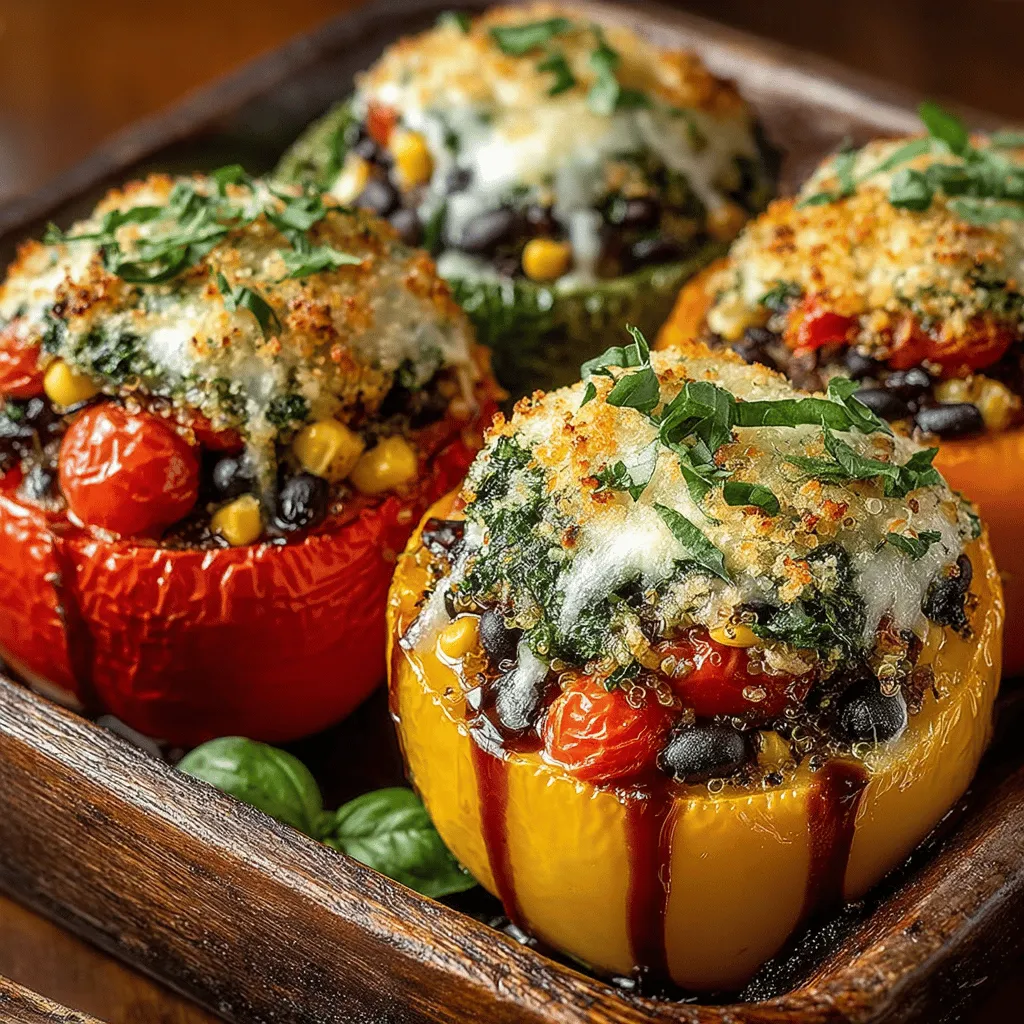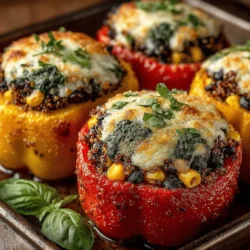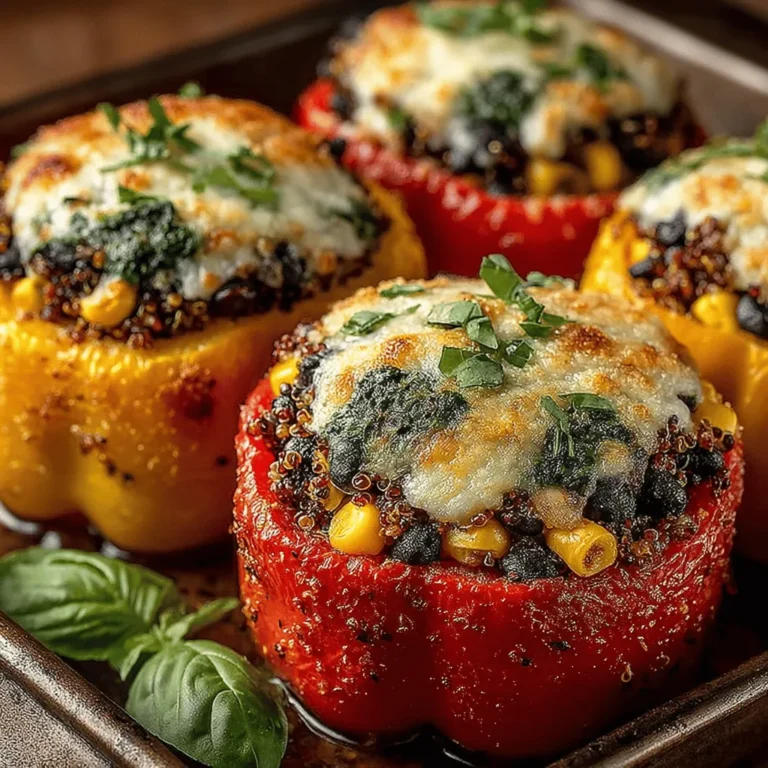Stuffed Balsamic Peppers: A Flavorful Journey into Culinary Delight
Stuffed vegetables have long been a staple in various culinary traditions around the world. From the classic Italian stuffed tomatoes to the Middle Eastern stuffed grape leaves, these dishes showcase the versatility and creativity that can come from filling fresh produce with an array of delicious ingredients. Among these, stuffed balsamic peppers stand out as a vibrant and nutritious option that captures the essence of seasonal flavors while catering to various dietary preferences.
Stuffed balsamic peppers are not only visually appealing with their bright colors but also packed with flavor and nutrients, making them a fantastic choice for health-conscious eaters. The dish is easily customizable, allowing for vegetarian and vegan adaptations that can satisfy a wide range of palates. Whether served as a main course or a side dish, these peppers are sure to impress your family and friends.
The Allure of Stuffed Balsamic Peppers
At the heart of stuffed balsamic peppers is the delightful combination of sweet bell peppers filled with savory quinoa, black beans, corn, and a rich balsamic reduction that ties everything together. The flavor profile is a harmonious blend of sweetness from the peppers, earthiness from the quinoa and beans, and a tangy kick from the balsamic vinegar. This balance not only delights the taste buds but also makes for a satisfying and hearty meal that can be enjoyed any time of year.
From a nutritional standpoint, stuffed balsamic peppers are a powerhouse of health benefits. Bell peppers are rich in vitamins A and C, antioxidants, and dietary fiber, which contribute to a well-rounded diet. Quinoa, a complete protein, offers all nine essential amino acids, making it an excellent choice for plant-based diets. Black beans add not only protein but also a variety of essential nutrients, including iron and magnesium. The inclusion of corn provides a natural sweetness and additional fiber, while the aromatic red onion and garlic enhance the dish with their robust flavors. Lastly, the spices—smoked paprika, cumin, salt, and pepper—add depth and warmth, rounding out the overall taste.
One of the best parts about stuffed balsamic peppers is their seasonal relevance. Whether it’s the peak of summer when bell peppers are at their best or the cooler months when you crave something warm and comforting, this dish is adaptable. It encourages the use of seasonal ingredients, allowing you to experiment with different vegetables, grains, and spices based on what is available.
Ingredients Breakdown
Before diving into the preparation, it’s essential to understand the key ingredients that make this dish so special:
– Bell Peppers: The star of the dish, bell peppers come in various colors—red, yellow, and orange—each offering unique flavor profiles. Red peppers tend to be the sweetest, while yellow and orange varieties have a more subtle sweetness. Green bell peppers are also an option, but they are slightly more bitter, which can provide a nice contrast to the other flavors.
– Quinoa: This ancient grain has gained popularity due to its health benefits. It is gluten-free, high in protein, and packed with essential nutrients like fiber and B vitamins. To ensure perfectly fluffy quinoa, rinse it under cold water before cooking to remove any bitterness. A common ratio is two parts water to one part quinoa for cooking.
– Black Beans: Rich in protein and fiber, black beans are a staple in many plant-based diets. They add a hearty texture to the stuffing and pair wonderfully with the sweetness of the peppers. Using canned black beans can save time; just make sure to rinse and drain them to reduce sodium.
– Corn: Fresh or frozen corn can be used in this recipe, adding a pop of sweetness and crunch. If using fresh corn, simply cut the kernels off the cob. Frozen corn is convenient and cooks quickly, making it an excellent option for busy weeknights.
– Aromatics: Red onion and garlic play a crucial role in enhancing the flavor of the stuffing. The sweetness of red onion, when sautéed, complements the other ingredients beautifully, while garlic adds a savory depth.
– Spices: A blend of smoked paprika and cumin adds warmth and complexity to the dish. Adjust the quantities to suit your taste, and feel free to experiment with other spices like chili powder or Italian herbs for a different twist.
– Balsamic Vinegar: This ingredient is what elevates the dish, providing a balance of acidity and sweetness. A good quality balsamic vinegar can make a significant difference in flavor, so choose one that you enjoy.
– Cheese: While the dish can easily be made vegan by omitting cheese or using a dairy-free alternative, cheese adds creaminess and richness. Options include shredded mozzarella, feta, or a plant-based cheese that melts well.
Step-by-Step Preparation Guide
Now that you’re familiar with the ingredients, it’s time to start the preparation. Follow these initial steps to ensure your stuffed balsamic peppers turn out perfectly.
Preheating the Oven: Before you begin assembling your dish, preheat your oven to 375°F (190°C). This temperature is ideal for baking the peppers, allowing them to soften while the filling cooks through. Preheating is an essential step, as it helps maintain consistent cooking temperatures, ensuring even baking.
Cooking Quinoa: To achieve perfectly fluffy quinoa, start by rinsing it under cold water in a fine mesh strainer. This step is crucial as it removes the saponins, which can impart a bitter taste. In a medium saucepan, combine one cup of rinsed quinoa with two cups of water or vegetable broth for added flavor. Bring the mixture to a boil over medium-high heat. Once boiling, reduce the heat to low, cover the pot, and let it simmer for about 15 minutes, or until all the liquid is absorbed. Remove the pot from heat and let it sit, covered, for an additional 5 minutes. Fluff the quinoa with a fork before incorporating it into your stuffing mixture.
With the oven preheating and the quinoa cooked, you’re well on your way to creating a delicious batch of stuffed balsamic peppers. As you continue with the recipe, you’ll find that each step brings you closer to a wholesome dish that’s sure to delight anyone at your table.

Preparing the Peppers
To start off your stuffed balsamic peppers, proper preparation of the bell peppers is crucial. Choose firm, vibrant peppers in your favorite colors—red, yellow, or green, depending on your taste preference. Here are some tips for cutting and cleaning the peppers effectively:
1. Choosing the Right Peppers: Look for peppers that are heavy for their size, with shiny skin and no blemishes or soft spots.
2. Cutting Technique: Place the pepper upright on a cutting board. Using a sharp knife, slice off the top of the pepper (the stem end) to create a lid. This helps maintain the pepper’s integrity while allowing enough room for stuffing.
3. Cleaning the Inside: Use a small paring knife or your fingers to remove the seeds and membranes. A spoon can also help scoop out the insides. Ensure you get rid of all the white pith, as it can be bitter.
These simple steps make a world of difference, ensuring that your stuffed peppers are not only visually appealing but also delicious.
Sautéing Vegetables
The next step in creating your stuffed balsamic peppers is sautéing the vegetables. This is an essential process that enhances the flavors of your stuffing. Here’s why it’s important:
1. Aromatics First: Start with minced garlic and diced onions in olive oil over medium heat. Allow them to soften and become fragrant—this usually takes about 3-5 minutes. This base will provide depth and richness to your filling.
2. Add Vegetables: Once your aromatics are ready, add in diced vegetables like zucchini, mushrooms, or spinach. Sauté them until tender, allowing their natural flavors to meld with the aromatics. This step is vital because it helps release moisture, preventing your stuffing from becoming soggy.
3. Seasoning: Don’t forget to season your sautéed vegetables with salt, pepper, and other herbs (like thyme or basil) to elevate the overall flavor profile.
Combining Ingredients
Once your vegetables are sautéed to perfection, it’s time to combine all your ingredients. Here’s how to ensure even distribution of flavors:
1. Base Ingredients: In a large mixing bowl, add cooked quinoa or rice (depending on your preference for grains). This serves as the heart of your stuffing.
2. Incorporate Vegetables: Gently fold in the sautéed vegetables into the grains. Use a spatula to ensure everything is evenly mixed without mashing the ingredients.
3. Add Flavor Enhancers: Stir in balsamic vinegar, a sprinkle of cheese (if desired), and any additional spices or herbs. Make sure the mixture is moist but not overly wet, as this can lead to a soggy filling.
4. Taste Test: This is a crucial step! Always taste your stuffing mixture and adjust the seasoning as needed. A dash more balsamic vinegar or a pinch of salt can make all the difference.
Stuffing the Peppers
Now, it’s time to fill the peppers. Here are some techniques to ensure that you fill the peppers without spilling:
1. Use a Spoon: A regular tablespoon or a cookie scoop can help you fill the peppers easily. Start from the bottom and work your way up to avoid creating air pockets.
2. Pack Gently: As you fill, pack the stuffing gently but firmly. This helps the filling hold together, ensuring it doesn’t fall out during baking.
3. Leave Some Space: Don’t overfill the peppers; leave about half an inch at the top. This space allows the filling to expand while baking.
Cheese Topping
Adding cheese on top of your stuffed peppers can elevate the dish significantly. Here’s how to choose the right cheese and its role in the recipe:
1. Cheese Options: Consider using mozzarella for a mild, gooey texture, or feta for a tangy contrast. Parmesan can also add a sharp bite and a nice crust when baked.
2. Cheese Layering: Sprinkle the cheese generously over the stuffed peppers. This creates a delicious golden crust as it melts and browns in the oven.
3. Texture and Flavor: The cheese not only enhances the flavor but also adds creaminess and helps bind the stuffing ingredients together, creating a delightful mouthfeel.
Baking Process
Baking your stuffed balsamic peppers correctly is crucial for achieving the best results. Here’s what you need to do:
1. Preheat the Oven: Set your oven to 375°F (190°C). This temperature allows the peppers to cook through while ensuring the stuffing warms up and the cheese melts beautifully.
2. Foil Cover: Place the stuffed peppers upright in a baking dish. Cover the dish with aluminum foil for the first half of the baking time. This helps steam the peppers, ensuring they cook evenly and become tender.
3. Baking Time: Bake the covered peppers for about 25 minutes, then remove the foil for the final 10-15 minutes. This allows the cheese to brown and the tops to crisp up, adding an appealing texture.
Final Touches
As your stuffed peppers come out of the oven, it’s time to focus on presentation and final flavor enhancements:
1. Garnishing: Consider garnishing with fresh herbs like parsley or basil for a pop of color and freshness. You can also drizzle a little extra balsamic reduction over the top for added flavor and visual appeal.
2. Serving Presentation: Serve the stuffed peppers on a large platter, showcasing their vibrant colors. Pair them with a side salad or roasted vegetables for a complete meal.
Serving Suggestions and Pairings
Stuffed balsamic peppers are versatile and can be paired with a variety of dishes and beverages to enhance your dining experience:
1. Accompaniments: A fresh arugula or spinach salad dressed with a light vinaigrette complements the dish nicely. Roasted vegetables or a grain salad can add texture and balance to the meal.
2. Beverage Pairings: Consider serving your stuffed peppers with a glass of crisp white wine, such as Sauvignon Blanc, or a light red like Pinot Noir. These wines will complement the flavors of the balsamic vinegar and the richness of the cheese.
3. Leftovers and Meal Prep: Stuffed peppers store well in the refrigerator for up to three days, making them an excellent option for meal prep. They can be reheated in the oven or microwave, making for a quick and satisfying lunch or dinner.
Nutritional Analysis
Analyzing the nutritional components of your stuffed balsamic peppers is essential for understanding their health benefits:
1. Caloric Breakdown: Each stuffed pepper contains approximately 250-300 calories, depending on the filling and cheese used. They are a filling option that can fit well into a balanced diet.
2. Macronutrients: The dish typically provides a good balance of carbohydrates from the grains, protein from the cheese and any added beans or meat, and healthy fats from olive oil.
3. Vitamins and Minerals: Bell peppers are rich in vitamins A and C, antioxidants that support skin health and immune function. The addition of vegetables and grains enhances the fiber content, promoting digestive health.
4. Dietary Considerations: This recipe can be easily adapted to suit dietary restrictions. Use quinoa or rice for gluten-free options. For a vegan version, skip the cheese or use a dairy-free alternative.
Cultural Context and Variations
Stuffed vegetables have a rich history across various cultures. Here’s a look at how this dish fits into the broader culinary landscape:
1. Cultural Inspirations: In Mediterranean cuisine, stuffed peppers often feature rice, herbs, and meats, reflecting the region’s flavors. Italian stuffed peppers may include sausage, while Middle Eastern versions often incorporate spices like cumin and coriander.
2. Variations: Feel free to get creative with your stuffing. Add ground meat, different grains like farro or couscous, or even beans for a protein boost. Spices can be adjusted to your liking—try adding cumin or smoked paprika for warmth.
3. Seasonal Adaptations: Consider seasonal variations as well. In the fall, adding pumpkin or butternut squash to your stuffing can provide a sweet and earthy flavor. In summer, fresh corn and tomatoes can add a burst of freshness.
Conclusion
Stuffed balsamic peppers offer a delightful combination of flavors, textures, and nutritional benefits, making them a fantastic dish for any occasion. Whether enjoyed as a main course or a side dish, these peppers embody an inviting and versatile meal that allows for creativity in the kitchen.
We encourage you to try this recipe and experiment with its variations to suit your taste. Embrace cooking as an opportunity to explore flavors and share delicious meals with your loved ones. Enjoy the journey of creating and savoring this wholesome dish!


